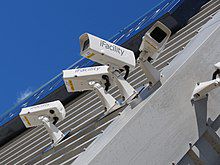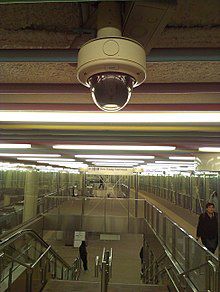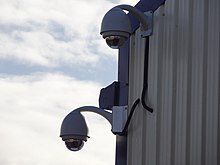“CCTV” redirects here. For the Chinese channel, see China Central Television. For other uses, see CCTV (disambiguation).
[columns][span4]
Surveillance cameras on the corner of a building.
[/span4][span4]
Dome camera in a rail station
[/span4][span4]
Dome CCTV cameras.
[/span4][/columns]Closed-Circuit Television (CCTV), also known as video surveillance, is the use of video cameras to transmit a signal to a specific place, on a limited set of monitors. It differs from broadcast television in that the signal is not openly transmitted, though it may employ point to point (P2P), point to multipoint (P2MP), or mesh wired or wireless links. Though almost all video cameras fit this definition, the term is most often applied to those used for surveillance in areas that may need monitoring such as banks, stores, and other areas where security is needed. Though Videotelephony is seldom called “CCTV” one exception is the use of video in distance education, where it is an important tool.
Surveillance of the public using CCTV is common in many areas around the world. In recent years, the use of body worn video cameras has been introduced as a new form of surveillance, often used in law enforcement, with cameras located on a police officer’s chest or head.[5] Video surveillance has generated significant debate about balancing its use with individuals’ right to privacy even when in public.
In industrial plants, CCTV equipment may be used to observe parts of a process from a central control room, for example when the environment is not suitable for humans. CCTV systems may operate continuously or only as required to monitor a particular event. A more advanced form of CCTV, utilizing digital video recorders (DVRs), provides recording for possibly many years, with a variety of quality and performance options and extra features (such as motion detection and email alerts). More recently, decentralized IP cameras, some equipped with megapixel sensors, support recording directly to network-attached storage devices, or internal flash for completely stand-alone operation.
There are about 350 million surveillance cameras worldwide as of 2016. About 65% of these cameras are installed in Asia. The growth of CCTV has been slowing in recent years.



😍 Liên hệ ngay với chúng tôi để nhận được tư vấn và hỗ trợ tốt nhất! 😍
Bắc Ninh Media
📞 Hotline: 0917658468 - 0222 6536789 - 0946748285
🌐 Website: https://bacninhmedia.com
🔗 Facebook: https://facebook.com/cameraquansatbacninh99
Bài viết liên quan
Tin tức cập nhật
Danh sách phần mềm xem camera quan điện thoại
Hiện nay trên thị trường có rất nhiều dòng đầu ghi hình camera quan sát do đó cũng...
Tin tức cập nhật
ĐẾN CUỐI NĂM 2022, VINFAST SẼ TRỞ THÀNH HÃNG XE ĐIỆN 100%
ĐẾN CUỐI NĂM 2022, VINFAST SẼ TRỞ THÀNH HÃNG XE ĐIỆN 100% Bà Lê Thị Thu Thuỷ, Phó...
Dịch vụ Lắp đặt hệ thống kiểm soát truy câp Tin tức cập nhật
Chuông cửa có dây và chuông cửa không dây – nên lắp đặt loại nào?
Chuông cửa hiện nay tuy chỉ là thiết bị nhỏ, tuy nhiên, nó lại là một vật dụng...
Cổng barie tự động, cổng xếp Tin tức cập nhật
Tư vấn quy trình lắp đặt cổng xếp tự động
Cổng xếp tự động là thiết bị khá phổ biến hiện nay. Cổng xếp được sử dụng cho...
Tin tức cập nhật
Đơn vị thi công lắp đặt hệ thống cửa từ, khóa từ uy tín chất lượng
Khóa chốt từ là một thiết bị hỗ trợ đắc lực cho vấn đề đảm bảo an ninh....
Tin tức cập nhật
Sử dụng khóa cửa điện từ chống trộm liệu có an toàn?
Sử dụng khóa cửa điện từ được biết đến như việc giúp bảo vệ an toàn và ngày...
Dịch vụ Lắp đặt camera quan sát Tin tức cập nhật
Đánh giá dòng camera Dahua chính hãng có tốt không?
Camera Dahua đã có mặt trên thị trường Việt Nam khá lâu, là một trong những dòng camera...
Dịch vụ Giải pháp Lắp đặt camera quan sát Tin tức cập nhật
Dịch vụ lắp đặt camera quan sát tại phường Đồng Kỵ thị xã Từ Sơn
Dịch vụ địa chỉ cửa hàng công ty mua bán, cung cấp lắp đặt và phân phối Camera quan...
Dịch vụ Thi công hệ thống báo động Tin tức cập nhật
Các loại hệ thống cảnh báo cơ bản được sử dụng nhiều
Thuật ngữ hệ thống cảnh báo đơn thuần được biết đến thông qua các loại biển báo cơ...